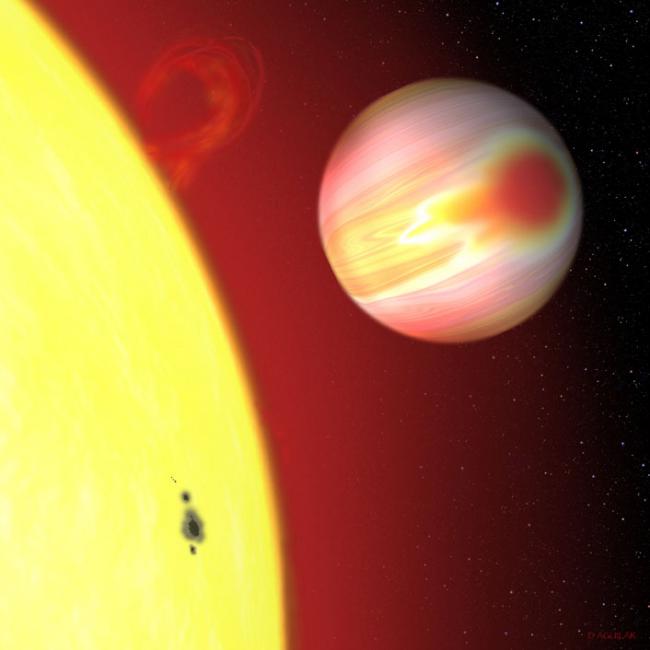
An artist's conception of the extra-solar planet around the nearby star HD 189733. CfA astronomers have been able to measure the weather on this planet -- the first such result for any extra-solar planet -- using a CfA-led infrared camera on the Spitzer Space Telescope. They find a large hot spot and very fast winds in the planet's atmosphere.
The star HD 189733 is located about sixty light-years from Earth. Two years ago a planet was discovered orbiting this star -- a so-called "hot Jupiter" planet, one whose mass is similar to the mass of Jupiter, but whose orbit passes very close to the star and whose atmosphere is therefore at a temperature over a thousand degrees kelvin. Besides being fascinating heavenly bodies in their own right, extra-solar planets offer important clues to how our own solar system formed, and why the Earth and planets have the properties that they do.
The planet around HD 189733 was discovered by close monitoring of the motions and brightness of the star; the orbit of the planet causes corresponding wobbles in the star's position, and fortuitously takes the planet across the face of the star as seen from Earth (a "transit"), thereby dimming the starlight periodically. CfA astronomers Heather Knutson (a student), David Charbonneau, and Lori Allen, together with six colleagues, have just announced in an article in Nature that they have been able to sample some of the weather on this planet, the first time such an amazing measurement has been made on any extra-solar planet.
The scientists used the Infrared Array Camera (IRAC) on the Spitzer Space Telescope to study the infrared emission from the star; the IRAC instrument team is led by SAO astronomer Giovanni Fazio. During 33 hours of constant monitoring, the astronomers followed the planet as it crossed the face of the star, continued outward in its orbit, and then moved around behind the star. Because the hot planet itself emits detectable infrared radiation, both the passage in front of the star (dimming the starlight) and the passage behind the star (blocking the planet's light) can be seen. They found that the emitted light during the passage varied in an asymmetric way, and are able to attribute the reason to a single "hot spot" in the atmosphere of the planet that is about twice as big as the Great Red Spot on Jupiter (and also much hotter, over 4000K.) Using models of the planet and its thick, cloudy atmosphere, the team also concluded that powerful winds, analogous to the jet stream on Earth, blow around the planet at speeds perhaps as fast as 1000 kilometers per second. Their models also suggest that water vapor might be abundant in the dense atmosphere. The discovery is a landmark in the study of extra-solar planets.